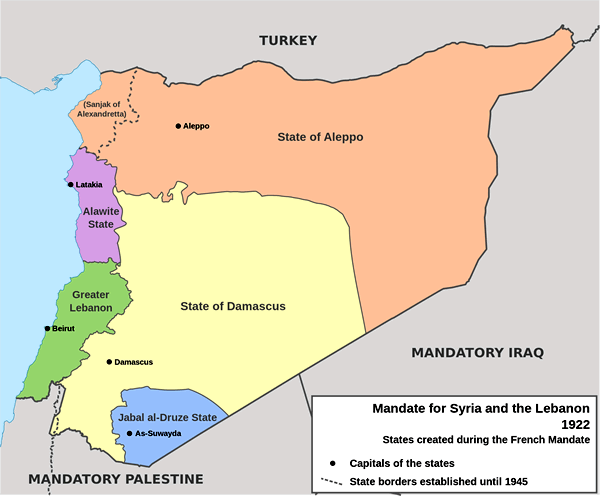 |
| French Mandate in Syria and Lebanon |
Following the defeat and the subsequent collapse of the Ottoman Empire in 1918, the geographic area of greater Syria came under French mandate rule as stipulated by the League of Nations in 1920.
Under French rule, the mandate authority, in addition to expanding the Ottoman Wilayat of Lebanon at the expense of Syria, divided Syria into four new separate districts: Aleppo, Latikia, Damascus, and Jebel Druze. French rule in Syria faced violence, rebellions, and political opposition by the Syrians, who never accepted French domination
The country now known as Lebanon was created on September 1, 1920, by enlarging the Ottoman Wilayat of Lebanon to include previously Syrian-held territory north and south of its borders.
  |
The entity of greater Lebanon (1920–26), as the new state was called, was fashioned after French republican ideals with a constitution and an executive president elected by a parliament.
In 1932 a census was conducted that resulted in the confirmation of 18 religious sects in the country. In an attempt to provide better representation in the government, the results of the 1932 census were incorporated in Article 95 of the constitution, establishing a confessional system.
The Kingdom of Syria (1918–20) was declared soon after the Ottoman army had been defeated in 1918. Headed by the Hashemite king Faysal (also Feisal) I, the kingdom rejected the French mandate.
The opposition to French rule did not end with the demise of the Hashemite Kingdom of Syria. On the contrary, it was fortified by a strong nationalist sentiment, and rebellions periodically erupted throughout the mandate years; these culminated in the Great Arab Rebellion of 1936, which resulted in the French bombardment of Damascus.
In 1940 during World War II, the French overseas territories were controlled by the pro-Nazi Vichy French government. In 1941 British and Free French forces overthrew the Vichy forces and granted Syria and Lebanon nominal independence.
In 1942 parliamentary elections in Syria brought the nationalist National Bloc to power; it began negotiating for independence with the French government. In Lebanon the political elite agreed on a formula to distribute power under the National Pact of 1943.
With U.S. and Soviet recognition, Syrian independence was granted in 1943. Lebanon was also granted independence the same year, but French troops remained stationed in both countries until 1946. Syria celebrated its independence day on April 17, 1946, while Lebanon celebrated independence day on November 22, 1943, and marked withdrawal day on April 17, 1946.